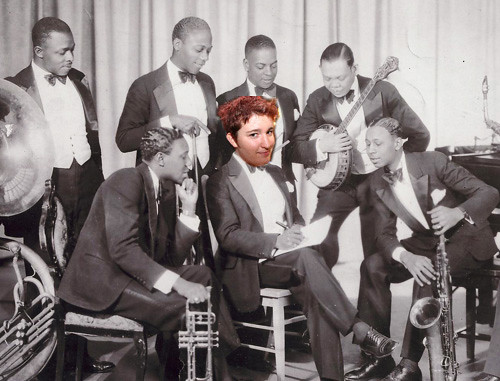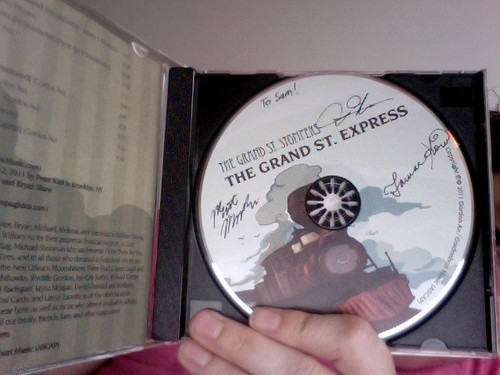It’s a slippery slope to full blown megalomania.
Moonstruck
Last night there was a lunar eclipse, and I was up at midnight to see it. It was an amazing thing, but now I am feeling the late night in my bones.

I’m ‘preparing’ for another Speakeasy (10:30pm next Friday night, Crossover studio, 22 Golburn St, Sydney), when I should really be lying on the couch watching Nick Cage rage against the injustice of his severed hand before being ravished by Cher. I should perhaps also be eating a little high-end chocolate.
But no. I’m fucking about with my music.
Last night I went to my second dance christmas party of the year, and it was good. Both dances featured Pugsly Buzzard, which is pretty ok, as he is pretty damn good. Last night he was playing with a drummer and a broken legged tuba player (there’s a joke in there somewhere), which was kind of odd, considering the crowd was mostly rock n rollers (that school teaches rock n roll and lindy hop). But it all turned out ok in the end. Most of us can get behind a bit of dirty Fats Waller or growly early rhythm n blues. I danced my pants off, sweating through three shirts and asploding my poor knees. I was leading an awful lot, more than following, and by the end of the night I had complete brain drain and couldn’t string two moves together. Need. More. Moves.
I think my favourite part of the night was dancing to a particularly awesome mashedup version of ‘Shake That Thing/Shimmy Like My Sister Kate’ with a really fun friend who also likes to dance de solo, and also does dancehall, so she’s packing serious hip isolation. No, wait, the best part of the night was dancing with her near some older rock n rollers. Older rock n rollers can be very conservative about gender stuff, so they were quite disapproving.
Actually, I know my favourite part of last night was after the band had finished, watching Bruce and Sharon dance to a rock and roll song and finally understanding why people dance rock and roll. I really can’t stand that partner stuff where the guy kind of hunches forwards with his elbow glued to his right hip, his arm bent 45 degrees, and kind of bobbing his head up and down, looking at the floor while he spins and spins and spins his partner. Boring Town. But Bruce and Sharon – with their exciting, dynamic amazing dancing of amazingness – made me realise what the big deal is, and I was almost moved to Cross The Floor and take up something a little more modern. Almost.
I liked it that the gig was at the Marrickville Hardcourt Tennis Club, which is also a Portugese social club, and that meant the food was interesting. This is one of the positives of the Australian social club scene. And I liked very much that the band played that Donald Harrison/Dr John version of ‘Big Chief’. The nice thing about a crowd from different dance styles and scenes is that there’s going to be someone out there who will give each song a go.
But today I am feeling very seedy.
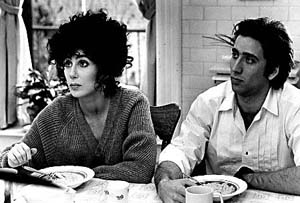
Last night followed a busy Friday night where Alice and I taught at Swingpit and I realised that when I’m teaching dance I’m just as ‘on’ as when I’m tutoring or lecturing, except I’m doing the equivalent to aerobics at the same time.
I was so bloody buggered afterwards. It was total fun, though, and it was really nice to talk about Frankie Manning to a bunch of new dancers, and the importance of pretending you’re a 90 year old man on his third hip. I think the best part of teaching is figuring out that the silliest (yet most authentic) jazz steps make other people giggle like fools as well. It’s very, very nice to see people who enter the room shy and uncomfortable at their first dance class transform into exhibitionists, simply through the power of ridiculousness. I’m also kind of fascinated by the fact that I’m talking about pretending to be a man when I’m dancing while I’m standing in front of a crowd of men who then use me as their model for movement. Genderflex to the power of n, to the point where it’s not even really worth bothering trying to figure out whether we’re using ‘masculine’ or ‘feminine’ movements. And I keep coming across deaf dancers, dancers who really get what’s happening in dance. Oh yeeaaah.
After we finished that, I social danced like a crazy person until I realised I was dying of dehydration and a bit tired and overwhelmed by the noise and had to sit outside for a little bit. Then I danced some more.
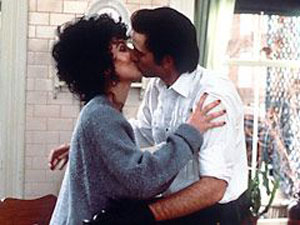
I do love dancing. I love it so much. And I’m quite enjoying not DJing as much. More dancing. More. Now I am madly frustrated by my lack of moves for leading. Luckily, there’s a solution for that problem.
Ok, so now I’m sitting on the couch, kind of melting in the humidity, but at the same time still stupidly dehydrated. Trying to get my brain around some music for the Speakeasy, and not doing so well. Everything feels a bit loud and a bit annoying. Really, the only solution is a little Japanese funk.
Or, really, a bit of light weight soul would be a better fit. I really like this particular version of I Need A Dollar by Aloe Blacc:
But, really, the best of all things is a bit of Sharon Jones
All that is the kind of action that goes down well at a Speakeasy (I’ve written about this event lots of times because I love it). I know, the name suggests a sort of 20s vibe, but it has that name because that’s what it was at first. But now it is legit. I like to do this soul/funk stuff, but I find it gets a bit old after a while, and I really tend to lean on people like Big Mama Thornton and then over into the gutsier vocal blues at higher tempos. Last time I did this gig, I really wanted to play the Propellerheads doing ‘History Repeating’ with Shirley Bassey because I remember dancing to it in nightclubs, but it doesn’t actually work that well when you compare it to really good music. I mean, it’s good, but it’s not brilliant. Shirley Bassey is, though.
I really like the way all this stuff is in stereo. It kind of blows my brain.
Really, a successful Speakeasy set ends up being 3 parts NOLA, 1 part Big Mama Thornton. But right now I think I need to watch Olympia Dukakis disapproving of weak-willed men for a couple of hours.
Sudden hot flush.
I want to BE that man. Or Dawn Hampton. Like a boss.
gorgeousness!
Oh, oh, you MUST watch this! reliquia portenas clip!
I love everything about it. I love those chins, and they way they’re lifted as a sort of challenge/invitation. I love that grace! The sophistication! But also the sheer, testosterone-laden, machismo of it! My favourite part is probably the very end when they raise their arms to accept applause and do the little pantomime with the handkerchief. This is just gorgeous. It’s exactly the type of masculinity I like to pretend I can do when I’m pretending to be a sophisticated mandancer. Except that I suspect I come off seeming a bit more like someone’s unsavoury uncle.
(linky c/o Jerry, who I feel as though I’m stalking with all these links and shares and reposts and such)
Swing and Bounce
This is the sort of post I don’t do very often because I don’t feel very confident of my understanding of dance and movement. There are plenty of people who have a better grasp of these things than I do. And, at the end of the day, I’m of the opinion that no amount of talking or writing or reading about dancing will make you a better dancer. If you’re not actually dancing, you’re not going to improve or understand movement.
The thing that really shifted my dancing from casual interest to solid addiction was the way it required my switching off my brain. This was important to me because I was busy with an MA and then PhD, and spent most of my time in brain and not in my body. I think it also made me a better tutor for uni students – talk less, listen more. Dancing – particularly following, but also leading – really needs you to just tell your brain to shoosh and to get on with being in your body. Strangely enough, Jerry’s just linked up Ruby’s post ‘To note or not to note’ on FB and she asks some neat questions about the value of taking notes or writing and reading about dance. I think that you learn most about dancing from dancing, and from dancing with as many people as possible. I actually think I learn most about leading from dancing with total one-class beginner follows and from working on my own in front of a mirror, trying out all the movements (try all the movements).
But I did that private lesson the other week, I’ve been doing more partner dance work, I’ve done a spot of dance teaching (that whole talking less thing is pretty bloody useful) and an interesting post at Lindy Hop Variations for Followers has triggered some dance-thinking over here in obcon land. So here’s a big long post where I’m really just floating ideas that I’m mulling over at the moment. I’m probably way off base here, but whatevs. I’m a work in progress, right? Never stop learning and all.
One of the things I find most difficult to write or talk about is a definition of ‘swing’. I mean the musical ‘feel’ of a song. Gunther Schuller has all that stuff about vertical and horizontal distances, but that’s really confusing and not entirely useful when you’re looking for a quick, simple image. I’ve often heard people talk about it in terms of a ‘delay’, and I think about it as being chillaxed, not racing towards the next beat, but hanging back and waiting til the very last moment before moving on to the next beat. But that’s not really all that helpful when you’re explaining how a swinging rhythm really works.
When I’m moving my body – dancing, I guess – to swinging music, the timing feels different to when I’m just listening to it. I feel that the ‘bounce’ (or some people call it pulse these days) is the heart of that swinging rhythm. A good, swinging late 1930s song at about 180bpm really feels as though it’s bouncing along. It’s not a jagged up-down timing, but more an arc through the air. I’ve just been reading through some research notes, looking for an article about black bands in the early days of radio and came across this comment about the work song:
The function of this song is to facilitate the task of chopping wood. As is typical of Afro-American work songs, in this song the process of chopping the wood becomes an intrinsic part of the music. The sound produced by the ax creates a component of the music which is essential to the structure of the song. The music, then, is not simply accompanying the work, the work becomes the music, and the music becomes the work. (Olly Wilson, ‘Black Music as an Art Form’ in The Jazz Cadence of American Culture, ed Robert G. O’Meally, New York: Columbia University Press, 1998:91).
I’ve just found this cool video of R.L.Burnside chopping wood in 1978
For me, this idea of rhythm as part of movement is really important to how I think about swinging rhythms. I tend to think about the beat in this type of song as being like the swing of an axe or a hammer. The upwards lift is quicker and stronger, but the downwards arc is a longer, slower force, directed by gravity. Each downwards arc moves at the same pace (because that’s how gravity works), but we can control both the upwards and downwards movement (I have just gone and watched a million videos of people chopping wood. I am such a nerd).
I think my thinking about dance is mostly informed by my interest in 1930s and 40s lindy hop, by Frankie Manning and by the Hot Shots. Whether I’ve actually understood the things they’ve been trying to teach me is another matter. When I think about ‘bounce’ (or pulse – whatevs), I think of each step or each bounce as a sink into the ground (ie sinking my hips down, with my knees bending, my ankles bending, and my arse going out and back to allow a deeper bend), and then a pushing up from the floor as I step onto the other foot, always keeping a bit of bend in the knee rather than locking it. This means my knees – my legs – are like coiled springs containing stored energy which I use for each step, or for faster reactions. These days I’m figuring out that my arse is actually the most important part of this ‘stored energy’ thing, and that I need to stop working my calves so hard. In a bounce, the movement starts in my ‘core’ (or my guts, or my hips or that network of muscles and things around the lower part of my torso. or my arse.) The depth of the bounce really depends on how much ‘time’ I have – faster songs mean less time.
So my bounce is kind of the same as an axe rising and falling. My muscles engage as I sink, or as the axe is raised, and then the energy is let out or used as I step or the axe falls.
I’m not sure of the physics of it all. The important part for me is that there’s that inevitable, undeniable delay. You can’t change the way gravity works. You can’t fight the swing in a swinging rhythm. This is why I think you need to have bounce or pulse when you lindy hop. You might crunch that bounce up until it’s like a tiny, power-bounce, right in your core and hard to see. But you need that little compression-and-release to dance.
If you’re not bouncing, you’re just walking. And even walking has bounce, if you’re relaxed, your core’s engaged and you’re bending your knees. You get a greater range of movement in your upper body (eg the swing of your arms, or a rotation at the waist) if you’re bent a little at the hips, you push from the arse/core and you let gravity move your arms about (rather than tightening them up). This bend at the hips (not sticking your arse out, but bending at the hips, so your back stays straight) engages your core muscles (eg your back, abs, sides, etc). Bending your knees engages your core muscles, especially if your weight is on the ball of your foot. It’s hard to do this if you don’t have your weight on the ball of your foot. It’s even harder if you keep your legs really straight and your knees locked. Also: ow.
I also think that if you don’t bounce, your timing is off. It always feels as though you’re rushing. I hate following a lead without bounce, as I always feel as though I have to run to get anywhere, particularly if they take huge steps. And if they’re really tight through the shoulders and I can’t feel where their weight is, or where it’s going. I also find that a natural consequence of bounce is less tension in the upper body. I don’t know why, but I always wonder if it’s because your lower muscles are doing the big job of keeping you upright and balanced, so you upper body can get on with doing crazy shit. Like throwing and catching a basketball. Or swinging an axe. And less unnecessary muscle tension means your body is doing less work and there’s less fatigue. And following or leading you is much nicer.
All that stuff about bounce is nice, because to me that’s how you make the swing in the music visible. But, really, I like that little discussion of work songs for the way it illustrates how rhythmic movement is incorporated into vernacular music and dance. Or the way everyday dance and music is about everyday movements and rhythms.
One of the things I’m most interested in at the moment, as a DJ, is how dancers ‘hear’ the beat, even when there isn’t an instrument banging it out. I’ve always had trouble with the way dancers in class speed up if you get them to do a basic rhythm without music. It’s something to do with the way hoomans in a group work – they speed up basic rhythms. But it drives me nuts. It’s as though they let the rhythm outside inflect the rhythm inside their bodies. Yet this idea of shared, increasing rhythm is partly what makes social dancing so much fun – we ‘catch’ rhythm from other people on the floor, and that shared feeling of rhythm kind of echoes and bounces back and forth, exaggerating the feeling. And that’s fun to work with, as a DJ, increasing and decreasing that shared musical feeling.
But the more experienced a dancer, the more likely they are to be able to feel a consistent beat, no matter what’s happening around them on the dance floor. I’ve noticed that newer dancers tend to have trouble with instrumentally sparse songs. Acapella can be the hardest, but small vocal groups with a guitar (eg Cats and the Fiddle) can be just as hard. And the most accessible and easiest to work with is a large band with a big rhythm section. Conversely, bands with choruses where instruments are doing different rhythms and melodies at once can be really confusing for new dancers.
You can see this when dancers are listening to a song with lots of breaks. Total beginners have real trouble predicting the beats and then coming back in on time. Dancers with some experience but without a real empathy for the music have difficulty doing anything other than standing still during the breaks – they can’t feel the rhythm continuing in the ‘silence’. And more experienced dancers with a sense of the broader structures of a song as well as the basic beat are most capable of adding in rhythms during that break (or of just riding out the break as a quiet point of contrast). Most interesting of all, if a dancer has bounce, then they’re never really standing still, even during breaks, unless they consciously choose to stop bouncing. And isn’t that the point – that we are dancing, not creating a series of tableaus?
So I’m pro-bounce. Because that’s what’s in swinging music. But I’m also for managing bounce to respond to music appropriately. Here, really, it’s not my business to tell other people what to do with their bodies. Dance how you like, how you feel. But for me, it’s fascinating to explore how bounce works in relation to music, and then – even more fascinatingly – how I can manage my bounce when I’m following a lead who doesn’t bounce. Do I abandon it completely? (NO!) Do I moderate it so as not to interrupt the lead? (YES!) The depth and feel of bounce can be a really simple way of responding to the intensity of the music. Big emotional, exciting moment – big bounce.
And, finally, I know I’ve been dancing with a badass, bouncy lindy hopper, because my heart rate is way up and I’m sweating rivers. Bounce simply takes more energy, and turns a low impact slouch-around-the-floor into a serious aerobic workout, engaging all your muscles and kicking your arse. A bouncing lindy hopper simply has a more energised set of muscles, which you can see in their dancing. And that’s the difference between dancing lindy hop and just standing about, right? You’re kicking your own arse and riding the adrenaline to funtown!
BIRTHDAY WIN
Lovely Doris sent me this as a belated birthday present. Doris is the best. She is my no.1 CD supplier, and she always sends the best bands, well before I’ve heard of them. EXCELLENT WORK DORIS.
On the blues
Bwaahahahahahahahahaah!
This is gold. I can’t explain all the levels of humour and piss-taking, because it’s all a bit complicated. But you can just watch this ‘straight’, as though it were a serious documentary. Because it is.
My favourite part: “[that music] was very racey. We called ’em race records”
extreme love for this sequence
MLX squee
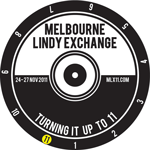
I’m trying and trying to think of a way to talk about MLX. But I can’t. I’m sorry, I’m getting emotional. Mostly because you can’t hug every DJ. No matter how much you love them.
Right here, I need to make clear my association with the Melbourne Lindy Exchange. I was involved with the very first one in 2001 as a basic volunteer, doing the usual volunteer stooge sort of stuff. That year was the first year a major weekend event with a proper social program was held in Australia. It also featured workshops. In 2002 I was on the organising committee and played a big role in managing the event over the weekend. In 2003 I took a break. In 2004 MLX coincided with Swing City and was huge. It was also the most expensive event in the country at that time.
In 2005 a team made up of previous years’ organisers formed a nonprofit organisation (the MJDA) to run the event, and ran MLX as an all-social weekend. That was the cheapest full pass event in Australia at the time. I was on that team. As the weekend proceeded, numbers at each event increased massively, as locals who hadn’t bought passes were told by their friends that shit was hot, and the interstate visitor numbers were bolstered. In 2006 the same team ran the event, and we consciously decided to step things up in a big way. Two rooms at the late nights. Masses of bands. Serious promotion. The full pass was still ridiculously cheap. Crazy cheap. I think we doubled the pass sales. 2007 was a similar story. It was just nuts.
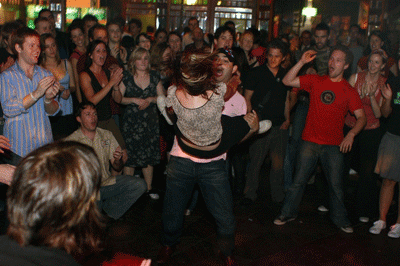
(a jam at MLX9, while I was DJing!)
Each year the attendee numbers increased massively. The event was run with the clear goals of being cheap and accessible for all dancers, yet also financially sustainable. I was involved because it was a nonprofit organisation, and because it is still stupidly cheap. It has a clear and firm policy of treating all volunteers really well, and the events themselves are very high quality. In 2008 I moved to Sydney and reduced my involvement to just finishing off coordinating the DJs. In 2009 I went to MLX as a punter and DJ and it was GREAT FUN. Same in 2010. BEST FUN EVER. I thoroughly recommend taking time off running your event to just attend as a punter. It makes you realise just how awesome it is, and it gives you a chance to actually enjoy the thing. This year I coordinated DJs for MLX11 and was blown away by just how tight and professional an event it is.
If you asked me whether I’d rather be involved with MLX as an organiser or as a punter/DJ, I’d be hard put choosing. I love going to it just as a punter because it’s an intense weekend in a great city, and total fun just to bum around at. But I also enjoyed working on the event this year because it’s such a big, interesting project. I think I’d be happy with either in the future. Maybe even prefer just DJing/puntering a bit, so I could really focus on DJing and dancing? Argh! What a choice to have to make!
So when I write about MLX, I’m a little biased. But my experience with the event over eleven years has varied so much, and I really feel now that I’m a contractor rather than a part of the core team, so I reckon I can write about it with some objectivity. Who am I kidding. But my love for MLX stems largely from its ethical intentions, its sheer quality as an event and its willingness to try new things and really set an example for other events in terms of music, working conditions for all involved and fiscal responsibility. It rocks.
Basically, MLX11 was the best event I’ve been to in Australia, ever. I’ve never been to an event with such a brilliant list of bands. Every single one was top shelf. And THEN, they ranged across all the best lindy hopping styles. Everything from hot early 30s medium sized band to juicy groovy hammond organ small group win. An 18 piece classic big band (from Perth!) doing arrangements so neat and performing them so well that I kept mistaking the band for the DJ. A chunky little swinging combo doing the sort of solid swinging powergroove/40s/50s swing that makes for brilliant lindy hop. A tight little late night band (from Perth!) made of dancers with a fun female vocalist that was actually really good. There were five bands, and they were all really, really good. I just couldn’t believe how good they were. I’ve never seen an Australian event with such consistently good and appropriate live music. Ever.
Then there were the DJs. I got to organise the DJs for MLX this year, so I able to put together a sampling of the strongest DJs I’d seen during the year (this is one of the reasons I travel a bit to dance events – so I can see who’s DJing, what they’re into, how popular they are with dancers) set them up in good time slots fun combinations, then just let them do their thing. That meant I was hearing my favourite sorts of music. But then things got BETTER! I couldn’t really get over just how GOOD all the DJs were. They’re all specialists in particular musical areas (including old scratchies, modern hot jazz bands, supergroove, chunky blues, classic big band swing), and I’d sort of set them up to do their sets expecting them to do X or Y or whatever it was I associated them with, musically. But EACH of them then managed their sets in the cleverest way, moving between styles and across genres to respond to the crowd’s interest, enthusiasm and stamina. It was just fucking magic. On Saturday night the main lindy hop room was still jammed with people lindy hopping at all the tempos at 5am! Even I was still in there dancing like a fool, and I was BUGGERED! I heard good reports from dancers all weekend, and I’m still getting emails and comments from people about the music. I just don’t think dancers could really get their heads around the quality of the music. I know I’m still kind of amazed. And I’m such a picky bastard, it’s very difficult to please me with every set.
The DJs at MLX11 included (in no particular order): Andy Fodor (Melb), Manon van Pagee (Melb), Trev Hutchison (Perth), Jarryd Reynolds (Adelaide), Matt Greenwood (Bris), Kenny Nelson (Colorado), Noni Mae Clarke (Melb), Sharon Callaghan (Melb), Keith Hsuan and me (Sam Carroll, Syd). The hardest part of coordinating DJs is knocking people back, and MLX is the highlight of the Australian DJing calendar, so lots of DJs look for sets at the event. It breaks my heart having to tell people the program is full, or that we’re looking for a specific type of DJ this year. There are still DJs that I’d like to add to a program like that, but we’d really reached maximum capacity this year. The program over all had a lot of live music – 1 band Friday evening, 2 Saturday evening/late night, 2 Sunday evening/late night – and this was GREAT. But it made for less DJing space. I was delighted, though, absolutely delighted by the way the DJs complemented the live music. It’s not often that I squee over a band break DJ’s work, but this MLX each of the band break DJs did really amazing jobs complementing, but not overshadowing the bands. It’s a tricky gig, and you’re really working all night, not just for the short blocks you’re playing music. There are performances, speeches, welcome dances and random interruptions to deal with during band break sets, as well as trying to avoid playing songs from the band’s set list. But these guys were guns.
MLX is generally the best social dancing weekend in the calendar, if you’re into hardcore dancing, but this year far outshone previous years. All through the weekend late night events ran over time. Main lindy hop rooms that usually finish at 4am were still pumping at 5.30am. Blues rooms just kept working and working. The Sunday didn’t end til 6am or something stupid. The venues were just right, the sound set ups were good, the provision of food and drink was important and done well, and the volunteers were cheery and well organised. All this, and MLX is a NONPROFIT event run by a team of volunteer coordinators. A committee. Anyone who’s ever worked on a dance event or on a committee knows just how difficult it is to get things done with a committee. Yet MLX consistently produces the best event in Australia. Every. Single. Year. I thought MSF was giving it a run for its money this year, but MLX pwnd all.
I like MLX because it’s just social dancing, and it tends to encourage random or crazy shenanigans. But not stupid shenanigans that make you cranky because they’re stopping you dancing. Fun shenanigans. I saw quite a few random costumes this weekend (my favourite was perhaps a bloke in a Black Swan costume for the Saturday dance), and I really liked the way the MLX theme (played to introduce the speeches and announcements) was, by the end of the weekend, met with loud singing-along and cheers, particularly as the MC Jarrod began initiating his speeches with some truly inspired interpretive dance. The theme was matched to the MLX theme – Turning it up to 11. I love this theme because it’s totally unrelated to lindy hop, it’s a bit lame (in a big hair way), and it also turned out to be totally fun to dress up for.
I think it’s worth talking a bit about why MLX is such good fun to DJ, and why it manages to get such brilliant sets from the DJs.
- Firstly, MLX doesn’t stint on sound gear. We did have some problems on Thursday night this year, but that’s because we were using a gorgeous little hall with very high ceilings and lots of hard, bouncy surfaces. It was a lovely space, but it did make for weird acoustics with recorded music. But the team helped us fix stuff up as much as possible (I was DJing that night and did struggle a bit at first). Otherwise, every venue had the right amount of amplification, a good quality mixer and a good, comfortable space for the DJ to set up with the right lighting. I know that when I DJ MLX I can play any song, no matter how old or scratchy, because the sound gear will make it sound sweet. So I DJ to the limits of my collection, rather than playing it safe.
- MLX treats DJs with lots of respect. DJs are introduced, back-announced, regularly cheered mentioned in speeches and listed all over the website. This year I made up a basic ‘Program of DJed music’ and put it up around the place so people could see who was on where and what they were doing in their sets, and it worked really well. The MLX peeps are also quick to buy DJs drinks and check in on them regularly to see if everything’s ok.
- MLX pays DJs well, better than any other event in Australia, and gives them free entry to the events they work. There are still Australian events which don’t give DJs free entry to the events they’re DJing, and this makes me FURIOUS. I think it shows how little music is valued, and how little understanding these event coordinators have of the work that goes into DJing. Sure, I think live music is more important, but DJs do actually fill out the bulk of most Australian dancing weekends. And at events where the bands can be quite dodgy, the DJs extra important. Personally, I won’t DJ an event that doesn’t give me free entry, because when I’m DJing, I’m working. I’m also loathe to do gigs where I don’t get paid. My exceptions are for new or nonprofit or charity events, or for my best buddies (ie my really close personal friends) or for house parties. Really, I do so much DJing these days, and I like social dancing so much, I need an incentive to bring my laptop and work for a few hours at a social event. But MLX pays more than other events, and has recently introduced a blanket pay rate for band breaks, which recognises the amount of work band break DJs do, and which no other event does. DJs are also paid for any extra DJing they do beyond their rostered sets. DJs are also paid for the full length of their rostered sets, even if that set has to be cut short. Well done MLX!
- MLX plans the DJing slots carefully and effectively. Set start and finish times are staggered, so that DJs can be properly introduced. Sets are at least an hour and a half long (unless there’s something difficult to work around), if not longer. The only challenge with MLX DJs is that they all love social dancing so much I had to stop myself pushing them to do more sets when I was planning the roster!
- Probably the best part of DJing at MLX is that they have a creative and innovative approach to programming DJs and events. They’re willing to try new things. Sometimes these new things don’t work out, but most of the time they do. The B-Sides room a few years ago was super popular, and allowed for an alternative to the main lindy hopping room. The B-Sides room was just that – a BSide, where DJs could play whatever they liked and not be constrained by rules bout ‘what’s good for lindy hop’. It was a massively popular room, and has only been replaced in the last few years because hardcore blues dancing has been so incredibly popular. While DJs in the main room are encouraged to experiment with themes, most of them end up doing straight ahead, unthemed sets simply because MLX is such prime lindy hop DJing. DJs don’t need a theme to spice things up for themselves, and just want to PLAY ALL THE THINGS.
To sum up, then, I really enjoyed coordinating DJs for MLX because it allowed me to pick a team of awesome DJs, treat them really well, and set them up to do just do their thing. And they DID that thing. I love DJing at MLX because I know it will be the BEST DJing experience of the year. I’ll be able to play all the stuff I love but might not play at home. MLX brings the fittest, most adventurous, open-minded dancers to the floor, and they’re all willing to just give things a go, even if a song is faster or unfamiliar. And I don’t think it’s just the experienced dancers who are like this at MLX. I see newer dancers getting out there and giving it a go. The event really feels like a good place to try new stuff. And, hopefully, people go home to their scenes as inspired and enthusiastic about dancing as I am right now.
The season of snot and ridiculously beautiful parrots

IMGP6151_rainbow-lorikeet, originally uploaded by RaeAllen.
It’s spring here in Sydney (well, summer, technically), and that means flowers and pollen and snot. We’re in a temperate/subtropical zone, near the coast, and we get masses and masses of rain in the spring and autumn months. The European seasons are particularly useless as guides to weather in Sydney… well, for pretty much all of Australia, but I really feel the discrepency most here. The Dharawal calendar makes a lot more sense. Which isn’t surprising, seeing as how it’s the sum of 40 000 years worth of observation and knowledge, rather than 200 years of trying to force a round peg into a square hole. Despite the best efforts of British colonists, we are not England, and they have not made Australia so. But most European-Australians insist on using the European seasons to describe our climate and get all emotional about falling leaves and ‘real’ seasons from a country on the other side of the planet which really only exists in their parents’ imagination. It gives me the shits a bit.
The Dharawal calendar:
January/February/March
Burran
Gaalung Marool
(hot and dry)
April/May
Marrai’gang
Bana’murrai’yung
(wet becoming cooler)
June/July
Burrugin
Tugarah Tuli
(cold, frosty, short days)
August
Wiritjilribin
Tugarah Gunya’marri
(cold and windy)
September/October
Ngoonungi
Murrai’yunggory
(cool, getting warmer)
November/December
Parra’dowee
Goray’murrai
(warm and wet)
Right now we’re in Parra’dowee, which means warm and wet. Which is what it is. Big, masive pouring rain for a week, straight-down rain, like a warm, heavy shower. And then things dry out and the plants go INSANE with their flowers, the birds go NUTS with the nectar and pollen in the flowers (especially the rainbow lorikeets, adrenaline-charged sex addicts at this time of year) and the bats get crazy for the fruit coming into season. All this is very picturesque, but by geez it makes for bad hayfever. Snot. Snot. Snot.
But Parra’dowee describes this season – warm and wet – far more effectively than ‘spring’. It’s not as though the little plants are crawling out of the frozen ground. The plants have been steadily growing for the last few months, and really only slowed down during the coldest part of the year. And ‘cold’ in Sydney means, oh, below 20*C at least! I never wear my Melbourne winter clothes, and never need scarves or woolly hats. But I’ve invested in lots more light cotton dresses since I’ve moved here (you can check the average temperatures and rainfall in these graphs).
Melbourne is (sort of) covered by the Brambuk calendar, which is pretty harsh. Very hot and dry in summer, very cold and often wet in winter. Total rubbish. It reminds me of living in Wagga, which was also rubbish, weather-wise.
Living in Sydney is like living in Brisbane or Fiji, but with less humidity and more moderate temperatures. Which is probably because they’re tropical places. I adore Sydney weather. Even in this wet season, the blocks of rain are bracketed by weeks of perfect, gloriously blue-skied days and gentle temperatures. All this makes Canberra all the stranger. Just over a mountain range to the east (sort of), the winters are freezing cold with snow, and the summers are bakingly hot and dry. Sydney is best. Canberra is our closest lindy hop scene, and we are the two closest scenes in Australia, so we visit each other for special events. It’s a three hour drive, or three hours on the bus for a $30 ticket (or $15 if you get organised early enough). One year coming home from Canberrang, the bus drove through snow flurries, then we arrived in Sydney where people were at the beach swimming.
Sydney is the best, chuck out all the rest.

